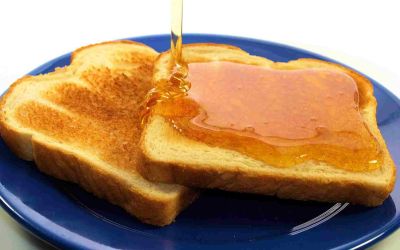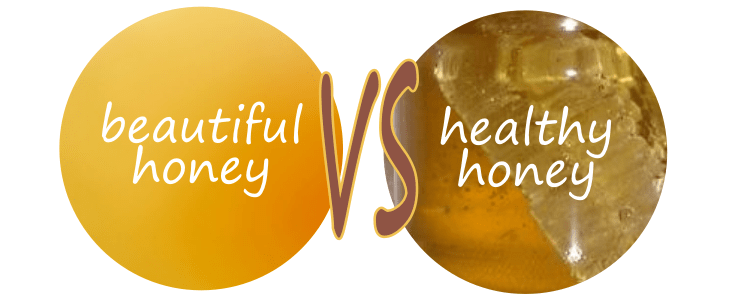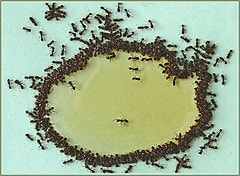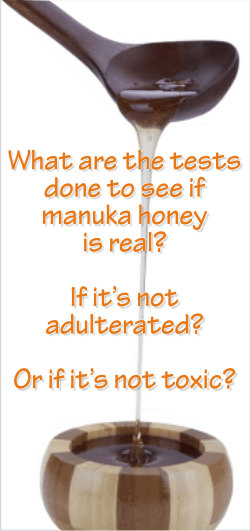There are a few methods to test real honey to see if it was mixed with water or other sugary syrups. None of these methods can tell if honey is organic or not, but they at least tell you if what you bought is only honey or some other substances like flour, starch, chalk, corn syrup, sugar etc.

1. It should not be very liquid.
If you take the jar from the shelf and turn it upside down, it should form an air bubble the shape of a pear, that will go slowly up, to the bottom of the jar. If it goes quickly then it could have been mixed with different substances to increase fluidity and quantity. It can also mean that the honey is not matured, that it has too much water in it due to the fact that it was taken from the combs’ cells too soon, and it was not dried sufficiently by the bees. (not their fault, but the beekeepers’. They wanted to speed the process.) This kind of honey is not as full in nutrients and enzymes as a ripe, mature one.
2. It must crystallize.
To be sure it’s pure honey, the safest way is to buy it already crystallized. Otherwise, depending on the type of flower, honey should crystallize in several months. Some honeys take even longer, due to their high content of fructose (see the case of honeydew honeys or some Australian types of honey like yellow box honey). See here some crystallization times.
We should associate the name of the honey with the time of crystallization. If, for example, in winter we have linden honey in a liquid form, it means it is not real.
It can also be really filtrated. This process turns what we call honey into a sugary substance. But to test this in a short time, place the honey in the fridge. If it doesn’t crystallize, it’s not pure.
further reading: What is artificial honey or fake honey? What we have in our food!
3. It shouldn’t dissolve quickly in water, or even in hot tea.
Stir some honey into a glass of water. Pure honey won’t dissolve, but rather form a lump and sink down to the bottom of the glass. Impure honey will easily dissolve in the water.
4. It should not perforate or be absorbed by the paper.
Use a blotting paper, coffee filter or tissue paper. Put some honey on them. If it’s impure honey the honey will be absorbed by the paper, if it’s pure honey it will not. It means it doesn’t have any water added.
5. Pure honey is a good skin regimen.
Rub some honey between your index finger and thumb until it disintegrates, it will be absorbed into your skin if there’s honey. Natural honey is not sticky. If what you rub is sticky, it has sugar or artificial sweetener in it.
6. Pure honey doesn’t stain clothes.

If you spilled real honey on your T-shirt, after washing there will be no stain.
7. Honey burns!
Do the test of the matchsticks. Take some matchsticks and stick them with their tips in honey. Wipe off the exceeding honey and strike to light them. If they do, then the honey is good. Fake honey will not light because of the moisture.
You can also use some cotton wicks. Place them in the honey, then keep them above the flame of a candle. Pure honey will burn. Impure honey with a high water content will not.
Or simply hold a lighted match to the honey. If it is natural it will melt and not begin to hiss immediately.
8. Goes clockwise when poured.
Pour half a cup of honey slowly into another cup. Honey will spin clockwise as you pour it. This is a result of the asymmetrical structure of honey molecules that give it a right hand bias.
 read more about the differences in “pure”, “clear” honey vs raw, healthy honey
read more about the differences in “pure”, “clear” honey vs raw, healthy honey
9. It hardens bread.
Spread it on a slice of bread. Natural honey will harden the bread in minutes. Adulterated and artificial honey will wet the bread because of the water content.
10. Ants don’t disturb natural honey.

Put some honey on a plate outside the house, near some ants, and wait. If many ants come, then honey is not pure. If no ants or 2 or 3 that died, the honey is pure. Honey bees instinctively build hives on trees and between rocks. They add an additive to the honey in order to protect it from pests, such as ants.
11. Natural honey caramelizes quickly.
Add 2 to 3 tablespoons to a microwave-proof bowl. Heat on high power until hot. Natural honey will caramelize quickly and never become foamy. Adulterated and artificial honey will become bubbly and difficult to caramelize. Once again this is because of the water.
12. Long lasting burning sensation if hot.
Put 2 spoons of honey in a little jar and then place it in a hot water bath. Heat it to 30-600C (1200 F) and taste it. I it is real honey, you will have a strong sensation in the throat, which will not disappear after 15 minutes!
13. Mature honey wounds on as a tape.
Take some honey with a spoon and quickly turn around its axis. Mature honey with normal humidity should wound on a spoon as a tape. Liquid honey, containing a lot of water, will flow.
14. Test the addition of starch.
Dissolve one part honey in one part water and add 1 drop of standard iodine. If the color of the solution does not change (doesn’t turn blue), then starch syrup is not mixed up. It’s pure. It can also be done with ethanol. In an aqueous solution of honey (1:2) add 96% ethanol and stir. If the solution remains clear there is starch syrup added.
15. Test the addition of chalk:
Take some honey, dilute it with distilled water and add a few drops of vinegar. The boiling of the mixture due to the release of carbon dioxide indicates the presence of chalk.
If you mix honey and water and then add 2 or 3 drops of vinegar essence, this mixture should not become foamy. If it does, the honey used was adulterated.
further reading: What is processed honey?
16. Mix it with an egg yolk and beat with a fork.
If the honey is pure, the yolk will look like it has been cooked.
17. Insert a hot stainless steel wire into it.
Heat a stainless steel piece of wire (a needle can do it) and insert it into the honey. A good honey should stick to the wire and not flow back into the jar.
18. Freeze it
Unadulterated and unprocessed honey should not freeze. This is in fact the best method to preserve the best qualities of honey. Take your fresh jar of honey and place it in the freezer. It will harden, of course, but it will not crystallize nor will it be frozen. You can still take a teaspoon out of it and put it in your tea. It will also guarantee that what you have is real and fresh honey.
19. Mix 1 part honey and 8 parts water, shake well and check for bubbles.
This is a method of testing real honey received from one of this site’s visitors. I haven’t personally tested it. But CK also sent us a picture, to convince us. Thank you CK.
“I knew a way of testing honey which is become popular recently in some of the Asia countries.
Mix honey with water in a portion of 1 to 8 in a clear bottle, shake it about 20-30 seconds.
Real honey will form some fine bubbles on top layer and it will last for hours.
Fake honey will not have fine bubbles and not lasting at all.”

_______
If you know any other method to try pure honey, or know that any of the methods listed above doesn’t work, please leave a comment and let’s make some light on this theme. 🙂
_______
***
***
References:
matchsticks picture credit: Collin Waldron
Fanica – Voinea Ene, Ghid de terapie naturista, 2006.
naturalnigerian.com
ehow.com
Free picture website
